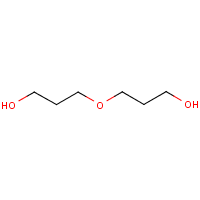Dipropylene glycol
Agent Name
Dipropylene glycol
Alternative Name
DPG
CAS Number
25265-71-8
Formula
C6-H14-O3
Major Category
Other Classes

Synonyms
Dipropylene glycol (6CI); Dipropylenglykol; Oxybispropanol; Propanol, oxybis-; DPG; [ChemIDplus]
Category
Propylene Glycols
Description
Colorless, odorless liquid; [HSDB] Hygroscopic; [CHEMINFO]
Sources/Uses
Used in antifreeze, air sanitizers, cosmetic stabilizers, polyester and alkyd resins, reinforced plastics, plasticizers, solvents, and steam set printing inks; [HSDB] Used in hydraulic break fluids, cutting oils, textile lubricants, industrial soaps, pesticide solvents, fragrances, skin care products, deodorants, hair care products, shaving products, facial makeup, and bath and shower products; [CHEMINFO]
Comments
Readily absorbed by GI tract and metabolically converted into propylene glycol; No deaths in animals inhaling 6-8 g/m3; 30% of rats exposed to 10% DPG in drinking water have kidney lesions; No fetal toxicity or teratogenicity in rats; [OECD SIDS: Dipropylene glycol (mixed isomers and dominant isomer) - 2001] May cause minor eye irritation; [CAMEO] Commercial dipropylene glycol (CAS # 25265-71-8) is composed of 3 isomers: (2,2' -dihydroxydiisopropropylether (CAS # 108-61-2); 2,2' -dihydroxydipropylether (CAS # 110-98-5); 2-hydroxypropyl-2'-hydroxyisopropylether (CAS # 106-62-7); [eChemPortal: SIDSUNEP] Causes mainly kidney and also liver and testicular injury in high-dose feeding studies of experimental animals; Oral LD50 (rat) = 14.8 ml/kg; [HSDB] May cause irritation; [MSDSonline] See "Propylene glycol."
Biomedical References
Exposure Assessment
MAK
100 mg/m3, inhalable fraction
Vapor Pressure
0.0319 mm Hg
Explanatory Notes
Flash point = 120 deg C; [HSDB] VP from ChemIDplus;
NFPA
must be preheated
Adverse Effects
Hepatotoxin
Hepatoxic (a) from occupational exposure (secondary effect) or (b) in animal studies or in humans after ingestion
Nephrotoxin
Yes
Reproductive Toxin
Yes
Diseases, Processes, and Activities Linked to This Agent
Processes
Industrial Processes with risk of exposure: